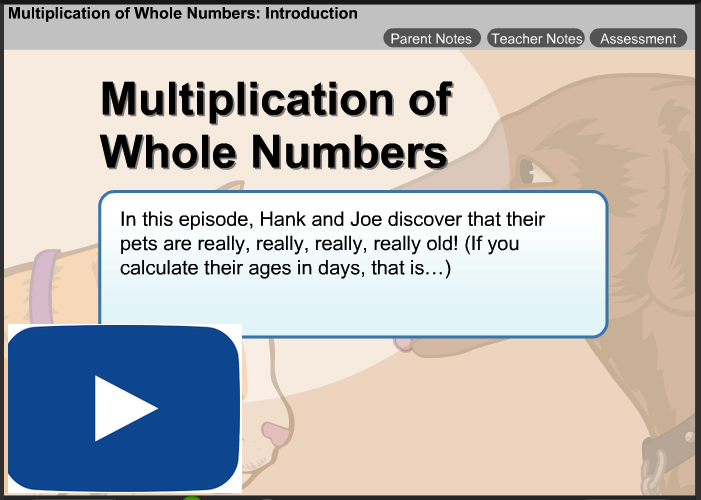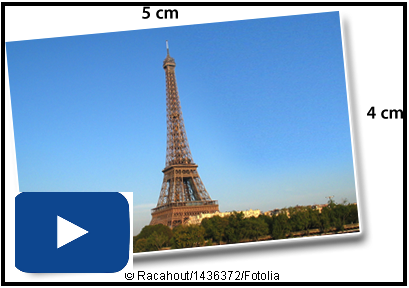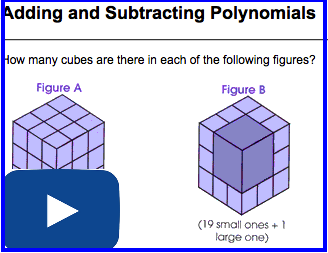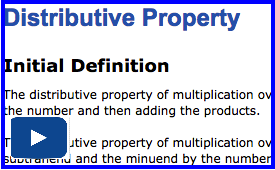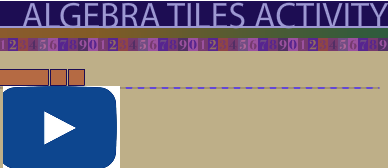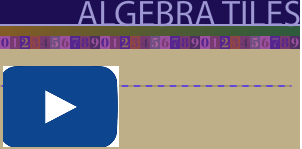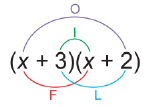Lesson 1: Multiplying Binomials
| Site: | MoodleHUB.ca 🍁 |
| Course: | Mathematics 10C |
| Book: | Lesson 1: Multiplying Binomials |
| Printed by: | Guest user |
| Date: | Friday, 19 December 2025, 5:23 AM |
Module 3: Polynomials
Lesson 1: Multiplying Binomials
Focus

© Antonio Iacovelli/shutterstock
Algebra is a branch of mathematics that deals with statements of relations, often using letters and other symbols to represent values. These symbols are then combined and balanced according to the rules of arithmetic. In this lesson you will first recall what it means to multiply two-digit numbers in arithmetic. Then you will begin to work with the abstract operation of multiplying binomials using physical objects you can move with your hands or manipulate using your computer. The results you obtain when you multiply binomials may provide an inspiration for encoding and decoding secret messages.
 Did You Know?
Did You Know?
The word algebra has its origins in an Arabic book written in the ninth century by a Persian mathematician named al-Khowarismi. The title of the book was al-jebr w’al-muqabalah, where al-jebr describes the “reunion of broken parts” and al-muqabalah refers to the process of “setting equal” or “balancing.”
Outcomes
At the end of this lesson, you will be able to
- model the multiplication of two given binomials, concretely or pictorially, and record the process symbolically
- relate the multiplication of two binomial expressions to an area model
- explain, using examples, the relationship between the multiplication of binomials and the multiplication of two-digit numbers
Lesson Questions
- How is multiplying binomials similar to multiplying two-digit numbers?
- How is the process of multiplying binomials similar to encoding a message?
 Lesson Completion and Assessment
Lesson Completion and Assessment
As you work through each lesson, complete all the questions and learning activities in your binder using paper and pencil, clearly labeling your work (they refer to this as your course folder). These include the Are you Ready, Try This, Share and Self Check questions. Check your work if answers are provided. Remember that these questions provide you with the practice and feedback that you need to successfully complete this course.
Once you have completed all of the learning activities, take the Lesson Quiz. This is the assessment for each lesson and is located under the Assess tab or by using the Quizzes link under the Activities block.
** Note – Share questions may have to be done on your own depending on your learning situation**
Module 3: Polynomials
Launch
Are You Ready?
Complete these questions in your course folder (binder). If you are experiencing difficulty, you may want to use the information and the multimedia in the Refresher section to clarify concepts before completing these exercises.
1. Determine each product without using your calculator. Show each step.
2. Add or subtract the following terms.
a. 2x +5 + 3x - 1
b. 3x2 -x + 6x - 4
c. 4x + 6x2 - 3 - 8x + 2x -4x2 + 6 + 2x2 - 2
3. Determine each product.
a. (5x)(7x)
b. 3m * 4n
c. (8x3)(2x5)
4. What is the distributive property?
5. Use the distributive property to expand each expression.
a. x(x + 6)
b. -7 (x + 2)
Once you have completed these exercises to the best of your ability, use the provided answer link to check your work.
If you feel comfortable with the concepts covered in the questions, move forward to Discover. If you experienced difficulties or want more practice, use the resources in Refresher to review these important concepts before continuing through the lesson or contact your teacher.
 Refresher
Refresher
The purpose of this section is to provide you with some resources to review in preparation for the lesson ahead. These resources may include videos, interactive applets, mini-lessons, and flash games to help you recall previously learned concepts. You can use these resources either before or after you try the Are You Ready? questions. Your teacher may also direct you to this section to review specific concepts.
-------------------------------------------------------------
Go to “Multiplication of Whole Numbers” to watch a demonstration on how to multiply two-digit numbers by
two-digit numbers. Under “Topics,” choose the eighth item titled “Multiplication with Symbols (2-Digit by 2-Digit)–Demo.”
----------------------------------------------------------------
The lesson titled “Multiplying Monomials” is a review of how to multiply monomials. You may want to obtain a set of algebra tiles from your teacher, use the “Algebra Tiles Template,” or use the interactive “Arranging Algebra Tiles” to follow along as you proceed through the examples.
------------------------------------------------------------------
Then go to “Adding and Subtracting Polynomials.” As you review the lesson, you will see a reference to the zero principle. The zero principle states that if you have the same number of positive and negative elements in a set, then the sum of those elements is zero. In terms of algebra tiles, the zero principle allows for an equal number of positive tiles and negative tiles to be cancelled since their sum is zero.
----------------------------------------------------------------
Go to “Distributive Property” at the Mathematics Glossary website to find out how the distributive property can be applied to the multiplication of monomials with polynomials.
---------------------------------------------------------------
Materials ** IMPORTANT**
You will want to have a set of algebra tiles handy as you proceed through this lesson. You can do one of the following:
- Obtain a set of algebra tiles from your teacher.
- Print two copies of the Algebra Tiles Template. You can either print each one on different coloured paper, or you can colour each of them by hand using two different colours. You need two different colours to help you to differentiate between positive and negative algebra tiles.
- Use the interactive “Arranging Algebra Tiles.” This applet will provide an unlimited supply of each type of tile. As necessary, you can use a screen capture tool to paste each arrangement into your glossary, notes, or assignment.
Module 3: Polynomials
Discover
In this Discover activity you will investigate patterns in multiplication arrays.
The following table is an example of a simple multiplication array. It can be used to determine the product of any two natural numbers up to 10. For example, to determine the product of 6 and 7, you can look for 6 down the left-hand column and 7 across the top row. You can then find their product by looking at the number in the square where the column and row intersect in the main body of the table. The result is 42.
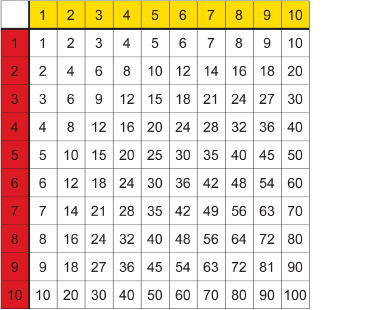
 Try This 1 - 8
Try This 1 - 8
Print (or copy by hand) and complete the following in your course folder ( binder).
Use the link below to check your answers to Try This 1 - 8.
Possible TT1-8 (Try This 1-8) Solutions
Module 3: Polynomials
Explore
Glossary Terms
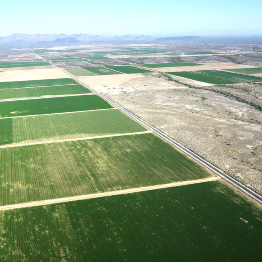
© iofoto/shutterstock
In this lesson you will learn how to multiply binomials. Add these terms and their definitions to your "Glossary Terms".
- algebra
- algebra tiles
- binomial
- distributive property
- monomial
- numerical coefficient
- polynomial
- variable
Once you have added these definitions to your handout, return the Glossary Terms document to your course folder.
You will explore two methods of multiplying binomials. These are the area method and the distributive property method.
Earlier in this lesson, you may have used algebra tiles. Using algebra tiles is a great way to start exploring the concept of multiplying binomials. These tiles can be moved around into different configurations and can, therefore, help you visualize the products of polynomials.
Area Method
Multiplying two binomials is very much like finding the area of a rectangle. In this case, each binomial forms a dimension of the rectangle.
In this section you will arrange algebra tiles into rectangular areas. Before you get started, you need to know a rule about the arrangement of algebra tiles.
A tile is correctly placed when its side lengths match the side lengths of adjacent pieces.
The following illustration shows how algebra tiles can be placed in relation to each other. Examples are shown of both proper placement and improper placement of tiles. Notice that in the proper placement of algebra tiles, the dimension of any given tile is located next to the same dimension of another tile.
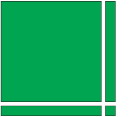
The following illustrations show two ways in which algebra tiles are improperly placed. In the first case, the tiles in the bottom row are not aligned with those in the top row. In the second case, the top edge of any of the first four smaller squares in the bottom row does not share the same dimension with the larger square above it.
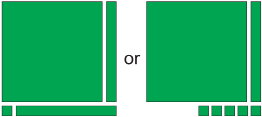
 Watch and Listen
Watch and Listen
Use the applet “Algebra Tiles Activity” to practise placing algebra tiles properly.
Now that you have an understanding of how algebra tiles can be placed, you can use them in a multiplication array to multiply binomials.
Retrieve your results from the Discover section. In TT 3, you should have completed the following multiplication array:

The sum of the top row is 13, and the sum of the left column is 12. This array helps you to find the product of 13 × 12.
The main body of the array is made up of a large square (blue) measuring 10 × 10, five rectangles (purple) measuring 10 × 1, and six smaller squares (salmon) with dimensions 1 × 1.
The total area is the following:
![]()
You may wish to confirm your answer using a calculator. Was the product of 13 × 12 also 156? Using algebra tiles or an array helps visualize multiplication using the area model. You can also see that, in multiplication, it is possible to break numbers into their factors and then determine the products of those smaller numbers. The final product is the sum of the smaller products.
Multiplying binomials is based on the same idea.
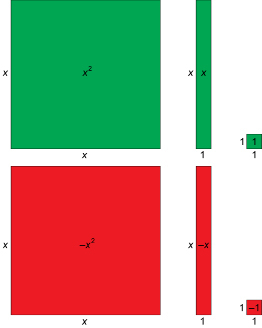
 Watch and Listen
Watch and Listen
Watch the video titled “Algebra Tiles: Multiplying Positives” to see how you can multiply binomials with algebra tiles and a multiplication array. This method is also known as the area method or rectangle method.
This method works equally well when there are negative terms in the binomial.
Next, watch the next two videos to see how you can find the product of binomials with negative terms:
- “Algebra Tiles: Multiplying Negatives”
- “Algebra Tiles: Multiplying Binomials with Mixed Signs”
As you watch, try to discover the two instances when positive tiles can be used.
----------------------------------------------
----------------------------------------------
The Arranging Algebra Tiles applet is a helpful tool for using the area method. As you complete the following Self-Check questions, you may do the work using the applet and then paste the screen captures into your answers.
----------------------------------------------
 Self-Check
Self-Check
Use the area method to find the following products.
SC 1. (x + 4)(x – 2)
SC 2. (x – 3)(x – 1)
SC 3. (2x – 1)(x + 3)
Distributive Property Method
The distributive property can be summarized in this way:
![]()
In other words, the product of a monomial and a polynomial is equal to the sum of the products of the monomial multiplied by each term of the polynomial.
The distributive property can be used to multiply binomials.
You can also multiply binomials by thinking of it in the same way that you think about multiplying two-digit numbers together.
For example, to represent the multiplication of 34 × 27, you can set up a multiplication array by breaking each number into tens and ones.
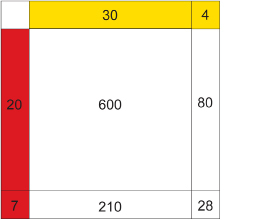
Notice that each number in the top row is multiplied by each number in the left column.
The product is the sum of the products in the array.
600 + 210 + 80 + 28 = 918
Now think about it without using the array.

Whether you use an array or the distributive property to model the multiplication, the process is the same: multiply each digit of the first number by each digit of the second number.
Multiplying binomials is based on the same idea. For example, to represent the multiplication of (x + 3)(x + 2), you can set up a multiplication array by breaking each binomial into an x-term and a constant.
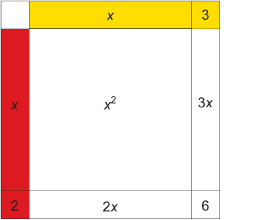
Just as you noticed in the previous array, each term in the top row of this array is multiplied by each term in the left column.
The product of the binomials is the sum of the products in the array.
x2 + 2x + 3x + 6
In the next example, you will perform the same calculation but without the array.
Example
Multiply (x + 3) by (x + 2) using the distributive property.
Solution
(x + 3)(x + 2)


It is a good idea to use arrows in your solution (as shown in the solution) to help you keep track of which terms you are multiplying together. Remember that you need to multiply each term of one binomial with each term of the other binomial.
 Tip
Tip
A way that you can remember how to multiply binomials using the distributive property is to use the acronym FOIL. The table summarizes the meaning of each letter.
|
Letter |
Meaning of |
What the Letter Means |
|
F |
First |
Multiply the first terms of each binomial. |
|
O |
Outer |
Multiply first term of the first binomial and the last term of the second binomial. |
|
I |
Inner |
Multiply the second term of the first binomial and the first term of the second binomial. |
|
L |
Last |
Multiply the last terms of each binomial. |
A visual representation of FOIL is as follows.
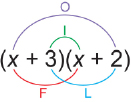
To watch a video to see to use the acronym FOIL to multiply binomials together, go to the Internet and type the keywords “Math Dude” into a search engine. These keywords should take you to the Montgomery County Public Schools website. On the right side of the website, look for the heading “Algebra 1 Unit 6.” Then choose the video titled “Multiplying Polynomials.”
 Watch and Listen
Watch and Listen
You can practise multiplying binomials. Use "The FOIL Method- Practice"
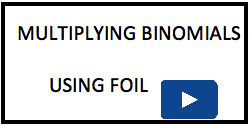
AND
Watch this Khan academy video for more reinforcement on "How to multiply Binomials".
 Read
Read
Work through the example of multiplying binomials in the textbook that you are using for this course. Take the time to examine the two methods of determining the product.
Foundations and Pre-calculus Mathematics 10 (Pearson)
Read “Example 1: Multiplying Two Binomials” on page 161. What are the similarities between the method of multiplication using algebra tiles and that of using the distributive property?
 Self-Check
Self-Check
Complete the following questions.
SC 4. (5x – 4)(x + 2)
SC 5. (x2 + 3)(x2 + 3)
SC 6. (x – y)(3x – 2y)
SC 7. (y + 4)2
SC 8. (a + b)(c + d)
 Try This 9
Try This 9
Once you are comfortable with the Self-Check solutions, practise doing more questions relating to the concepts in this lesson.
Complete the following in your course folder ( binder).
TT 9. Foundations and Pre-calculus Mathematics 10 (Pearson), questions 5, 9, and 12 on pages 166 and 167.
Use the link below to check your answers to Try This 9.
Possible TT9 (Try This 9) Solutions
Module 3: Polynomials Connect
 Lesson Assessment
Lesson Assessment
Complete the lesson quiz posted under the Assess tab or by using the Quizzes link under the Assess tab. Also, ensure your work in your binder (course folder) is complete.
 Project Connection **NOT ASSIGNED**
Project Connection **NOT ASSIGNED**
In Lesson 1 you discovered how to multiply binomials by multiplying each term of one binomial with each term of the second binomial. One way to do this is to use a multiplication array. Individual products are organized in the array and then reassembled into the final result.
A word square is a cipher that is analogous to the process of multiplying polynomials. Letters, instead of monomials, are arranged in a square formation in a word square. The letters are then reassembled into a ciphertext that appears random.
To demonstrate how a word square works, imagine that you want to encipher the message “I LIKE POLYNOMIALS.”
Step 1: Write the letters of the message in a 4 × 4 square, working downward in columns. Proceed from the left column to the right column.

Step 2: Write the words that appear across each row to reveal the encryption:
IEYI LPNA IOOL KLMS
You can decipher this code by executing the same steps in the reverse order. Place the letters into a square, but arrange the letters across each row. The message is revealed by reading down each column from left to right.
Now go to the Unit 2 Project and complete your Module 3: Lesson 1 component.
 Going Beyond
Going Beyond
